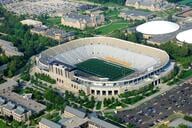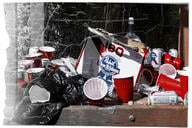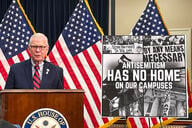You have /5 articles left.
Sign up for a free account or log in.
After a month marred by racist and homophobic incidents on campus, Oberlin College officials were startled when a student reported seeing a person in Ku Klux Klan-like robes walking near the campus Afrikan Heritage Center on Monday morning. They responded swiftly, canceling classes and "non-essential events," and filling the afternoon with a teach-in, solidarity demonstration and community convocation (the latter had already been scheduled for later in the week).
So it was equally surprising Tuesday when news surfaced that the whole thing was probably a misunderstanding. Oberlin police told Ohio's Chronicle-Telegram newspaper that while they couldn't find a person in KKK garb and couldn't corroborate that report, they did find a non-student wrapped in a blanket and another witness who saw a person in a blanket.
Some critics proceeded to mock Oberlin's apparent overreaction. The conservative commentator Michelle Malkin, an Oberlin graduate, said the college has a “self-victimization/manufactured racism impulse.” The University of Pennsylvania professor Alan Kors, a co-founder of the Foundation for Individual Rights in Education, told a local columnist that students and administrators devoting attention to a supposed KKK stunt was “the worst possible response.”
But others say Oberlin was in a precarious position. The ordeal points to the ways in which incidents like those throughout February (multiple cases of intimidating notes, posters and graffiti) can influence – and in some cases, drive – institutional response.
“You can say this is a community response that was certainly precipitated by that one event, but I think it’s the larger context and series of events that’s the main driving force,” said Sean Decatur, dean of Oberlin’s College of Arts and Sciences. “It was the level of anger, fear, frustration that the community was already at that this report clearly fed into. In a sense, I’m not quite sure that I can even imagine separating the notion of a response to this one particular report.”
Decatur said Wednesday night that campus safety and Oberlin police still haven’t come to any conclusions about the report, which is still under investigation. The Plain Dealer of Cleveland reported Thursday night that the college has invited the Federal Bureau of Investigation to aid in the inquiry.
Colleges from time to time discover that they’ve been victim to a hoax hate crime, in some cases after huge statements and actions -- from campus evacuations to vigils to speeches by college presidents – in response to an incident. Regardless of the scenario to which they’re responding, though, standard procedure is for college officials to fully investigate any seemingly legitimate allegation of harassment.
In the case of Oberlin, the question then becomes, how legitimate was the allegation?
W. Scott Lewis, managing partner at the National Center for Higher Education Risk Management, said that “without a doubt,” officials were thinking about the events of February when they decided to cancel classes. (Among the incidents, chronicled by The Oberlin Review: hate speech, at least one with a swastika, found in faculty mailboxes; physical assault and robbery of a student in which the assailant used a derogatory ethnic term; vandalism in campus buildings including swastikas and scrawling “Nigger” on Black History Month posters; and signs reading “whites only” above a water fountain, “Nigger oven” inside an elevator and “no Niggers” on a bathroom door.)
“They apparently thought that was the appropriate and proportionate response, given their campus climate,” Lewis said. “And I think that’s an interesting statement, given that it turned out to be not [what they thought].”
Lewis wouldn’t call the response an “overreaction,” because Oberlin did have to consider everything that had been going on and how people around campus were reacting to it. But he noted that the move could send some unintended messages.
One is a potential chilling effect. If the entire campus is essentially shut down because of one misinterpretation, might adjunct faculty members worry about what they say in class?
And, harking back to his own college days, Lewis mentioned another potential concern.
“If you were a student and you saw Oberlin respond by shutting down everything for a day for what they thought was happening, if that student just really, really wants to stir the pot, they now know how to do that,” Lewis said.
Decatur dismissed that notion, citing the seriousness with which the student body took Monday’s impromptu community events: two-thirds of the students showed up to participate.
“If we were the type of campus where you would cancel classes and everyone would go to their dorms and hang out and watch TV, that would be one thing,” he said. “I think the culture at Oberlin is such that -- the spirit is such that -- it was a day in which classes were canceled, but not a day in which learning was turned off.”
Oberlin was right to consider the level of fear and concern already hanging over the campus, said Jen Day Shaw, associate vice president and dean of students at the University of Florida and chair of the Knowledge Community for Campus Safety and Emergency Preparedness for NASPA: Student Affairs Administrators in Higher Education.
“I would rather see an institution close for a day and be able to have time to plan and prepare for possible escalation of events, safety of the community and other possible resources (such as communitywide education or forums) then have events escalate without being prepared to keep everyone safe and feeling able to work and learn,” she said in an e-mail.
And with Monday’s educational events, the statement Oberlin made in the interim – between the time it closed classes and the coming weeks and months in which it figures out how to move toward a more positive climate – was both intentional and necessary, officials said.
“I think this is a very important reminder that Oberlin is part of the larger world, and there are things like this that happen all over the country,” Decatur said. “It’s actually important to have times to look inward and see, what are ways in which the institution can be improved in the community, and pushed to make sure it’s living up to the standards it values?”




